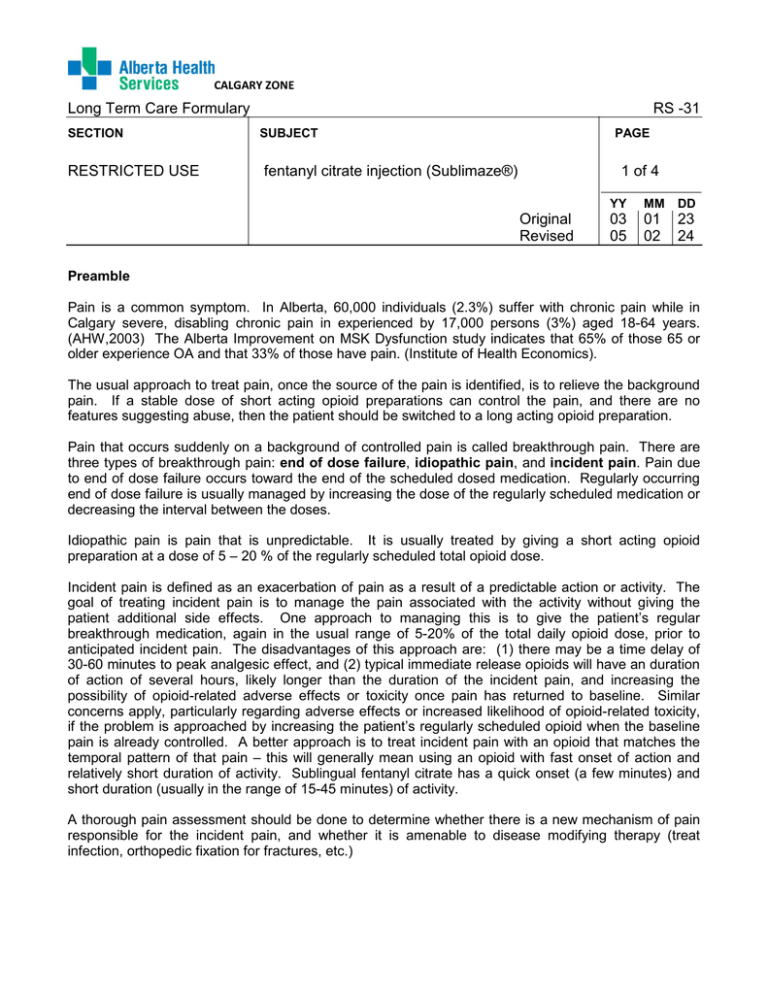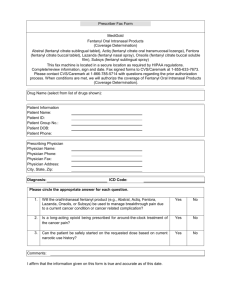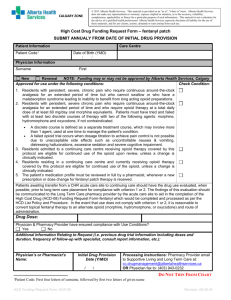fentanyl citrate injection
advertisement

CALGARY ZONE Long Term Care Formulary SECTION RESTRICTED USE RS -31 SUBJECT PAGE fentanyl citrate injection (Sublimaze®) 1 of 4 Original Revised YY MM DD 03 05 01 02 23 24 Preamble Pain is a common symptom. In Alberta, 60,000 individuals (2.3%) suffer with chronic pain while in Calgary severe, disabling chronic pain in experienced by 17,000 persons (3%) aged 18-64 years. (AHW,2003) The Alberta Improvement on MSK Dysfunction study indicates that 65% of those 65 or older experience OA and that 33% of those have pain. (Institute of Health Economics). The usual approach to treat pain, once the source of the pain is identified, is to relieve the background pain. If a stable dose of short acting opioid preparations can control the pain, and there are no features suggesting abuse, then the patient should be switched to a long acting opioid preparation. Pain that occurs suddenly on a background of controlled pain is called breakthrough pain. There are three types of breakthrough pain: end of dose failure, idiopathic pain, and incident pain. Pain due to end of dose failure occurs toward the end of the scheduled dosed medication. Regularly occurring end of dose failure is usually managed by increasing the dose of the regularly scheduled medication or decreasing the interval between the doses. Idiopathic pain is pain that is unpredictable. It is usually treated by giving a short acting opioid preparation at a dose of 5 – 20 % of the regularly scheduled total opioid dose. Incident pain is defined as an exacerbation of pain as a result of a predictable action or activity. The goal of treating incident pain is to manage the pain associated with the activity without giving the patient additional side effects. One approach to managing this is to give the patient’s regular breakthrough medication, again in the usual range of 5-20% of the total daily opioid dose, prior to anticipated incident pain. The disadvantages of this approach are: (1) there may be a time delay of 30-60 minutes to peak analgesic effect, and (2) typical immediate release opioids will have an duration of action of several hours, likely longer than the duration of the incident pain, and increasing the possibility of opioid-related adverse effects or toxicity once pain has returned to baseline. Similar concerns apply, particularly regarding adverse effects or increased likelihood of opioid-related toxicity, if the problem is approached by increasing the patient’s regularly scheduled opioid when the baseline pain is already controlled. A better approach is to treat incident pain with an opioid that matches the temporal pattern of that pain – this will generally mean using an opioid with fast onset of action and relatively short duration of activity. Sublingual fentanyl citrate has a quick onset (a few minutes) and short duration (usually in the range of 15-45 minutes) of activity. A thorough pain assessment should be done to determine whether there is a new mechanism of pain responsible for the incident pain, and whether it is amenable to disease modifying therapy (treat infection, orthopedic fixation for fractures, etc.) CALGARY ZONE Long Term Care Formulary SECTION RS -31 SUBJECT RESTRICTED USE PAGE fentanyl citrate injection (Sublimaze®) 2 of 4 Original Revised YY MM DD 03 05 01 02 23 24 Introduction The purpose of this protocol is to effectively manage severe incident pain refractory to increasing doses of usual analgesics with short acting opioids, or where increasing doses of usual analgesics results in unacceptable adverse effects. Incident pain is defined as exacerbation of pain as a result of a predictable action or activity. Situations in which the use of fentanyl citrate maybe considered are as follows: Planned turns Transfers, ambulation Bathing Changing clothes Dressing changes Disimpaction Note: Background persistent pain should be treated with long acting opioids. Onset and Duration of Action The parenteral form of Fentanyl can be used subcutaneously or sublingually depending on the person’s ability to manage sublingual administration. If administered sublingually, the drugs have to remain there for at least 5 minutes. Oral bioavailability of fentanyl is negligible and therefore this medication cannot be taken orally. Patients are generally unable to keep more than 1.5ml to 2ml under the tongue before it dribbles into the mouth, rendering it inactive. The benefits of fast acting and ultra-short lasting opioids such as fentanyl for “incident” pain are that the medication may be given minutes before a planned activity to avoid pain, and it minimizes the lingering adverse effects of a long acting opioid for breakthrough pain when the patient is at rest. The onset of action is approximately 5-15 minutes. The peak effect occurs within 20 minutes. The duration of action has a maximum effect up to 45 minutes. Fentanyl Citrate should not be used sublingually in patients in the following situations: 1) Unable to hold the medication under their tongues for at least 5 minutes (fentanyl citrate maybe given subcutaneously in this case) 2) Decreased level of consciousness because of risk of aspiration and dribbling down the throat, inactivating the medication. (fentanyl citrate maybe given subcutaneously in this case 3) If they do not have incident pain Note: Decrease saliva production can delay absorption of sublingual fentanyl CALGARY ZONE Long Term Care Formulary SECTION RS -31 SUBJECT RESTRICTED USE PAGE fentanyl citrate injection (Sublimaze®) 3 of 4 Original Revised YY MM DD 03 05 01 02 23 24 Side effects: drowsiness, sedation, nausea, and vomiting. These effects are more prominent in patients not experiencing severe pain. Respiratory depression is a dose dependent side effect. It could potentially occur with an initial fentanyl dose greater than 200 mcg intravenous. The side effects of fentanyl are minimal when the protocol is followed. Steps of the Incident Pain Protocol This protocol uses a stepwise approach to reduce incident pain. In a frail elderly patient who is opioid naïve, start at Step 1. If the patient is opioid tolerant, then start at Step 2. If pain is not controlled on the current step, then titrate up to the dosage required for optimal effect. Doses are the same for subcutaneous and sublingual administration. (See Application of the Incident Pain Protocol). Step 1: Fentanyl 12.5mcg Step 2: Fentanyl 25 mcg Step 3: Fentanyl 50 mcg Step 4: Fentanyl 100mcg ( If patient unable to tolerate the volume in a single dose then the 2 ml volume may be given 2 doses of 50mcg/1ml at an interval 5-10minutes apart) Application of the Incident Pain Protocol 1) The fentanyl citrate is administered sublingually/subcutaneously 10 minutes prior to an anticipated activity (See Steps of Incident Pain Protocol for doses). For sublingual administration ,the patient is asked to hold the medication under the tongue for about 510minutes without swallowing it. If the medication is swallowed, it will not be as effective (less medication will reach the systemic circulation, onset of action will be delayed, and half-life will be prolonged). 2) If a given dose is sufficient, the patient will be comfortable with movement. After 10 – 15 minutes, if the initial dose appears to be insufficient, then the same dose may be repeated up to two further doses, at 10-15 minute intervals. 3) Consider moving to the next step of the protocol if the maximum number of doses (three) is required to achieve comfort, or is insufficient to achieve comfort. One may move to the next step of the protocol after one hour of the last dose of fentanyl. The physician should be contacted before proceeding to the next step of the protocol. 4) The Incident Pain Protocol may be used up to q1h. The effectiveness of the intervention should be monitored utilizing a pain flow sheet. © 2013 Alberta Health Services. This material is provided on an "as is", "where is" basis. Alberta Health Services does not make any representation or warranty, express, implied or statutory, as to the accuracy, reliability, completeness, applicability or fitness for a particular purpose of such information. This material is not a substitute for the advice of a qualified health professional. Alberta Health Services expressly disclaims all liability for the use of these materials, and for any claims, actions, demands or suits arising from such use. CALGARY ZONE Long Term Care Formulary SECTION RESTRICTED USE RS -31 SUBJECT PAGE fentanyl citrate injection (Sublimaze®) 4 of 4 Original Revised YY MM DD 03 05 01 02 23 24 Reference: 1) AGS Panel on Persistent Pain in Older Persons. The Management of Persistent Pain in Older Persons. JAGS 50:S204-S224, 2002 2) Alberta Health and Wellness, Chronic Pain in Alberta: A portrait from the 1996 National Population Health Survey and he 2001 Canadian community Health Survey. Health Surveillance Alberta Health, Edmonton, Alberta. May 2003. 1-26 3) College of Physicians and Surgeons of Alberta. Management of Chronic Non-Malignant Pain. CPSA Guideline, February 1993 4) Davis M. Guidelines for breakthrough pain dosing. American Journal of Hospice & Palliative Care. 20(5) 2003 p:334 5) Gloth, FM. Pain Management in Older Adults: Prevention and Treatment. JAGS 49:188-199, 2001 6) Harlos, M. Palliative Care Incident Pain and Incident Dyspnea Protocol. http://palliative.info/IncidentPain.htm 7) Institute of Health Economics News Release: About the Alberta Improvements for Musculoskeletal Disorders. May 2002 Website address: http://www.ihe.ca/aims/releases/020530.cm 8) Mahon K. The Search for Best Practice. The Palliative Care Platform. Vol. 7(1), 2003 p. 2-3 9) Payne R.; Coluzzi P. Long Term Safety of Oral Transmucosal Fentanyl Citrate for Breakthrough Cancer Pain. Journal of Pain and Symptom Management. 22(1), 2001 p:575583 10) Regional Pain Program Steering Committee. Calgary Health Region Regional Pain Program: Principles, goals and recommendations for integrated pain services. August 6, 2004 (Draft)

